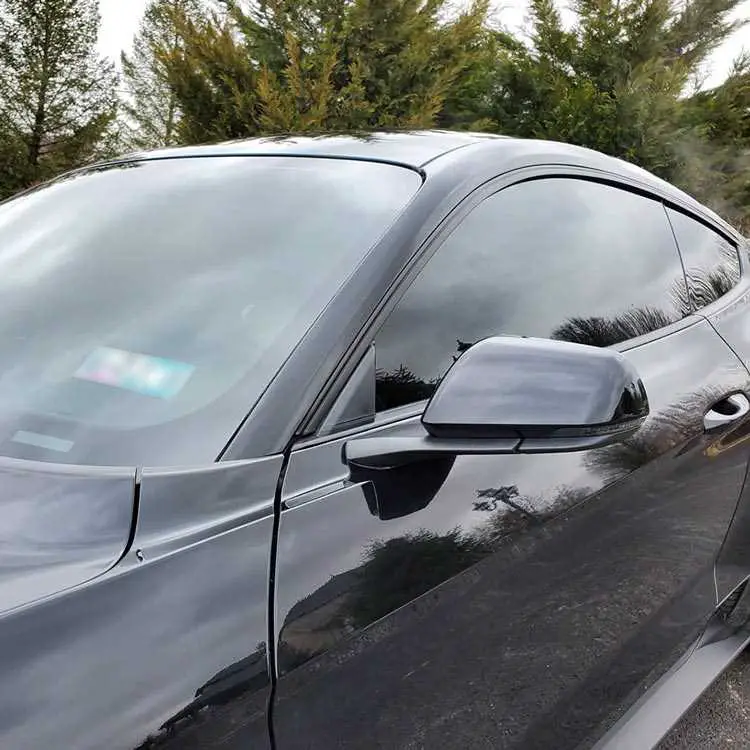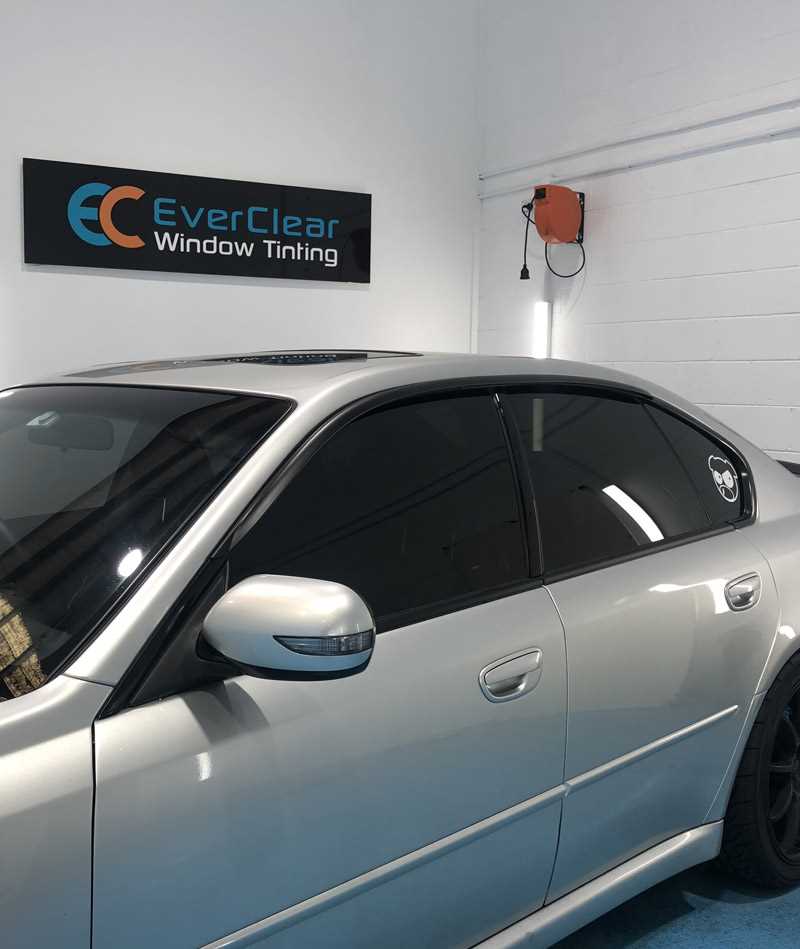Last Updated on February 9, 2024 by Vadym

Carbon window tint is a type of window film that is used to reduce glare, block harmful UV rays, and provide privacy for your vehicle. It is made with carbon particles, which give it a unique dark appearance and excellent heat rejection properties.
One of the main benefits of carbon window tint is its ability to block up to 99% of UV rays. This is especially important because UV rays can not only damage your skin, but also cause your car’s interior to fade and deteriorate over time. Carbon window tint helps to protect you and your car’s interior from these harmful rays.
In addition to blocking UV rays, carbon window tint also helps to reduce glare from the sun and other bright lights. This can improve visibility and make driving safer, especially during the day or in bright conditions. It also adds a layer of privacy to your vehicle, making it more difficult for people to see inside.
Another advantage of carbon window tint is its heat rejection properties. The carbon particles in the film act as a barrier, preventing heat from entering your vehicle. This can help to keep your car cooler on hot days and reduce the need for air conditioning, potentially saving you money on fuel costs.
Overall, carbon window tint provides a number of benefits for both you and your vehicle. From blocking UV rays to reducing glare and providing privacy, it is a popular choice for many car owners. If you are considering getting window tint for your vehicle, carbon window tint is definitely worth considering.
Key Benefits of Carbon Window Tint
Carbon window tint is a popular choice for many car owners due to its numerous benefits. Here are some key advantages of using carbon window tint:
1. Heat rejection: Carbon window tint is known for its excellent heat rejection properties. It can block a significant amount of the sun’s heat, helping to reduce the temperature inside your car. This can make your drive more comfortable, especially on hot summer days.
2. UV ray protection: Another important benefit of carbon window tint is its ability to block harmful UV rays. Exposure to UV rays can lead to skin damage and increase the risk of skin cancer. Carbon window tint can block up to 99% of UV rays, providing you and your passengers with added protection.
3. Glare reduction: Tired of being blinded by glare while driving? Carbon window tint can help with that too. It can reduce the amount of glare coming from the sun, headlights, or other reflective surfaces, making it easier and safer to drive in bright conditions.
4. Fade protection: Sunlight can cause the interior of your car to fade over time. Carbon window tint can help protect your car’s interior by blocking a significant amount of the sun’s harmful rays. This can help preserve the color and condition of your upholstery, dashboard, and other interior components.
5. Privacy: Carbon window tint can also provide added privacy for you and your passengers. It can make it difficult for people outside to see into your car, helping to keep your belongings safe and giving you a sense of privacy while driving.
Overall, carbon window tint offers a range of benefits, including heat rejection, UV ray protection, glare reduction, fade protection, and privacy. It not only enhances your driving experience but also helps to keep you and your car protected from the sun’s harmful rays.
How Carbon Window Tint Works
Carbon window tint is a type of window film that uses a carbon-based dye to achieve its dark appearance. Unlike traditional window tint, which uses a metal-based dye, carbon window tint is made by mixing carbon particles with a polymer adhesive. This combination creates a darker and more opaque window tint that blocks more light and heat from entering a vehicle or building.
Carbon window tint works by absorbing and reflecting sunlight. The carbon-based dye absorbs the sun’s rays, preventing them from passing through the window and into the interior. This helps to keep the interior of a vehicle or building cooler and more comfortable, as less heat is able to enter.
In addition to blocking heat, carbon window tint also blocks harmful UV rays. The carbon particles in the tint can block up to 99% of UV rays, which helps to protect the interior of a vehicle or building from fading and damage caused by the sun’s rays. UV rays are not only damaging to the skin, but they can also cause materials like upholstery, carpeting, and wood to deteriorate over time.
Another benefit of carbon window tint is that it reduces glare. The dark appearance of the tint helps to minimize the amount of glare that enters a vehicle or building, making it easier to see and reducing eye strain. This can be especially useful while driving or working in front of windows.
Furthermore, carbon window tint provides privacy and security. Its dark appearance makes it difficult for outsiders to see into a vehicle or building, giving occupants a greater sense of privacy. Additionally, the tint creates a protective barrier that holds glass together in the event of an accident or break-in, reducing the risk of shattered glass causing harm.
Overall, carbon window tint is an effective and versatile solution for blocking heat, UV rays, glare, and increasing privacy and security. Its carbon-based composition offers superior performance compared to traditional metal-based window tints, making it a popular choice for vehicles and buildings alike.
Choosing the Right Carbon Window Tint
Carbon window tint is a popular choice for those looking to enhance the appearance and functionality of their windows. However, with so many options available, it can be overwhelming to choose the right carbon window tint for your specific needs. Here are some factors to consider when making your decision:
| Factor | Description |
|---|---|
| Visible Light Transmission (VLT) | The VLT measures the amount of visible light that can pass through the window tint. Depending on your preferences and local regulations, you may want to choose a tint with a higher or lower VLT. |
| Heat Rejection | If you live in a hot climate or want to reduce the heat coming into your vehicle, it’s important to consider the heat rejection properties of the carbon window tint. Look for a high heat rejection percentage to keep your interior cooler. |
| UV Protection | One of the main advantages of carbon window tint is its ability to block harmful UV rays. Ensure that the tint you choose offers a high level of UV protection to protect yourself and your passengers from the sun’s harmful rays. |
| Durability | Consider the lifespan of the carbon window tint you are considering. Look for a tint that is scratch-resistant and fade-resistant to ensure it will last for years without losing its effectiveness. |
| Color | Carbon window tint is available in a variety of colors, including neutral, charcoal, and black. Choose a color that complements the aesthetic of your vehicle and meets any legal requirements in your area. |
By taking these factors into consideration, you can choose the right carbon window tint that not only enhances the appearance of your windows but also provides you with the desired level of functionality and protection.
Installation Process of Carbon Window Tint
Installing carbon window tint on your vehicle is a straightforward process that can provide numerous benefits such as heat reduction and UV protection. This tint is made from carbon particles infused into a polyester film, resulting in a durable and long-lasting solution for your windows. Here is a step-by-step guide on how to install carbon window tint:
| Step 1: | Begin by measuring your vehicle’s window dimensions. You can use a measuring tape to accurately determine the size of each window. |
| Step 2: | Next, clean the windows thoroughly to ensure that there is no dirt, dust, or debris on the surface. Use a glass cleaner and a microfiber cloth to achieve a clean surface. |
| Step 3: | Prepare the carbon window tint film by cutting it to the appropriate size using a sharp utility knife. Make sure to leave a small margin around the edges to allow for installation. |
| Step 4: | Fill a spray bottle with a mixture of soapy water. This solution will be used to apply the tint to the window surface. |
| Step 5: | Spray the window with the soapy water solution, ensuring that the entire surface is covered. This will create a slippery surface, allowing for easier installation of the tint. |
| Step 6: | Remove the backing from the adhesive side of the carbon window tint film. Be careful not to touch the adhesive side with your fingers to avoid leaving any fingerprints. |
| Step 7: | Apply the adhesive side of the film to the wet window surface. Use your hands or a squeegee to smoothly place the tint on the window, ensuring there are no air bubbles or wrinkles. |
| Step 8: | Use the squeegee to remove any excess water and to push out any remaining air bubbles. Start from the center and work your way towards the edges, being careful not to damage the film. |
| Step 9: | Allow the tint to dry for at least 48 hours before rolling down the windows or cleaning the surface. This will ensure that the adhesive fully adheres to the window. |
| Step 10: | After the tint is completely dry, inspect the windows for any imperfections or areas that may require further adjustment. Use a heat gun to carefully heat and mold the film if necessary. |
Following these steps will result in a professionally installed carbon window tint that provides privacy, protection, and aesthetic appeal to your vehicle.
Maintenance Tips for Carbon Window Tint

Maintaining your carbon window tint not only keeps it looking great, but it also helps to prolong its lifespan. Here are some maintenance tips to help you take care of your carbon window tint:
1. Clean with a non-abrasive cloth: When cleaning your carbon window tint, avoid using abrasive materials or scrub brushes that can scratch the surface. Instead, use a soft cloth or microfiber towel to gently wipe away any dirt or debris.
2. Use a mild cleaning solution: If plain water isn’t enough to remove stubborn residue or dirt, you can use a mild cleaning solution. Mix a small amount of mild soap or window cleaner with water and apply it to the tinted surface. Gently scrub the area with a soft cloth or sponge, then rinse with clean water.
3. Avoid harsh chemicals: It’s important to avoid using harsh chemicals or solvents on your carbon window tint. These can damage the tinted film and cause it to bubble or peel. Stick to mild cleaning solutions and avoid anything containing ammonia or alcohol.
4. Be gentle when drying: When drying your carbon window tint after cleaning, avoid using rough or abrasive towels. Instead, gently blot the surface with a soft towel or cloth to remove any excess moisture.
5. Avoid scratching or scraping: Be cautious when using objects near your window tint, as scraping or scratching can damage the film. For example, when scraping ice or snow off your car windows, use a scraper with a rubber or plastic edge to avoid scratching the tint.
6. Keep pets and sharp objects away: To prevent accidental damage to your carbon window tint, keep pets with sharp claws away from the windows. Additionally, avoid placing any sharp objects or tools near the tinted surface to avoid scratching or tearing the film.
By following these maintenance tips, you can ensure that your carbon window tint stays in great condition and continues to provide you with the privacy and heat reduction benefits you desire.
Common Myths About Carbon Window Tint
Carbon window tint is a popular choice for many car owners due to its numerous benefits, including heat and UV ray reduction, improved privacy, and enhanced aesthetics. However, there are several myths surrounding carbon window tint that can lead to misconceptions. Let’s debunk these myths and separate fact from fiction:
Myth 1: Carbon window tint is not as effective as other types of tint.
This is simply not true. Carbon window tint is known for its superior performance when it comes to reducing heat and blocking harmful UV rays. It can provide comparable or even better results than other types of tint, such as dyed or metallic tints.
Myth 2: Carbon window tint obstructs visibility.
While it is true that some tints can impair vision, carbon window tint is designed to maintain optimal visibility. It allows for excellent clarity, both during the day and at night, ensuring that you can see clearly while driving.
Myth 3: Carbon window tint is illegal.
There are specific laws and regulations regarding the darkness and reflectivity of window tints, but carbon window tint is generally compliant with these regulations. It is available in various shades, allowing you to choose a tint that meets legal requirements while still providing the desired level of privacy and protection.
Myth 4: Carbon window tint will fade or bubble over time.
High-quality carbon window tint is designed to be durable and resistant to fading or bubbling. However, improper installation or low-quality tint can result in these issues. To ensure longevity and prevent any problems, it is essential to have the tint installed by a professional and choose a reputable brand.
Myth 5: Carbon window tint will interfere with electronic devices.
This myth is unfounded. Carbon window tint does not disrupt the functioning of electronic devices, including cell phones, GPS systems, or radio signals. It is non-metallic and non-conductive, meaning that it will not interfere with any electronic signals.
Now that we have debunked these common myths, you can make an informed decision if you are considering carbon window tint for your vehicle. Remember to consult with a professional tint installer to ensure proper installation and to choose a high-quality carbon window tint that meets your needs and preferences.
